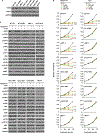A recombinant human protein targeting HER2 overcomes drug resistance in HER2-positive breast cancer
- PMID: 30674653
- PMCID: PMC6409101
- DOI: 10.1126/scitranslmed.aav1620
A recombinant human protein targeting HER2 overcomes drug resistance in HER2-positive breast cancer
Abstract
Resistance to current human epidermal growth factor receptor 2 (HER2) inhibitors, such as trastuzumab (Ttzm), is a major unresolved clinical problem in HER2-positive breast cancer (HER2-BC). Because HER2 remains overexpressed in drug-resistant HER2-BC cells, we investigated whether PEPDG278D can overcome the resistance. PEPDG278D is a recombinant enzymatically inactive mutant of human peptidase D, which strongly inhibits HER2 in cancer cells by binding to its extracellular domain. Here, we show that PEPDG278D is highly active in preclinical models of HER2-BC resistant to Ttzm and other HER2 inhibitors and also enhances the therapeutic efficacy of paclitaxel. The therapeutic activity is underscored by its ability to bind to HER2 and free it from protection by mucin 4, disrupt its interplay with other receptor tyrosine kinases, and subsequently direct HER2 for degradation. PEPDG278D also down-regulates epidermal growth factor receptor, which contributes to drug resistance in HER2-BC. In contrast, Ttzm, whose therapeutic activity also depends on its binding to the extracellular domain of HER2, cannot perform any of these functions of PEPDG278D PEPDG278D inhibits HER2-BC cells and tumors that carry clinically relevant molecular changes that confer resistance to Ttzm. Our results show that HER2 remains a critical target in drug-resistant HER2-BC and that PEPDG278D is a promising agent for overcoming drug resistance in this disease.
Copyright © 2019 The Authors, some rights reserved; exclusive licensee American Association for the Advancement of Science. No claim to original U.S. Government Works.
Figures






Similar articles
-
Depleting receptor tyrosine kinases EGFR and HER2 overcomes resistance to EGFR inhibitors in colorectal cancer.J Exp Clin Cancer Res. 2022 Jun 2;41(1):184. doi: 10.1186/s13046-022-02389-z. J Exp Clin Cancer Res. 2022. PMID: 35650607 Free PMC article.
-
Targeted dual degradation of HER2 and EGFR obliterates oncogenic signaling, overcomes therapy resistance, and inhibits metastatic lesions in HER2-positive breast cancer models.Drug Resist Updat. 2024 May;74:101078. doi: 10.1016/j.drup.2024.101078. Epub 2024 Mar 13. Drug Resist Updat. 2024. PMID: 38503142 Free PMC article.
-
Targeting ErbB-2 nuclear localization and function inhibits breast cancer growth and overcomes trastuzumab resistance.Oncogene. 2015 Jun;34(26):3413-28. doi: 10.1038/onc.2014.272. Epub 2014 Sep 1. Oncogene. 2015. PMID: 25174405
-
The root cause of drug resistance in HER2-positive breast cancer and the therapeutic approaches to overcoming the resistance.Pharmacol Ther. 2021 Feb;218:107677. doi: 10.1016/j.pharmthera.2020.107677. Epub 2020 Sep 6. Pharmacol Ther. 2021. PMID: 32898548 Free PMC article. Review.
-
Overcoming trastuzumab resistance in HER2-positive breast cancer using combination therapy.J Cell Physiol. 2020 Apr;235(4):3142-3156. doi: 10.1002/jcp.29216. Epub 2019 Sep 30. J Cell Physiol. 2020. PMID: 31566722 Review.
Cited by
-
Combination Therapy and Nanoparticulate Systems: Smart Approaches for the Effective Treatment of Breast Cancer.Pharmaceutics. 2020 Jun 8;12(6):524. doi: 10.3390/pharmaceutics12060524. Pharmaceutics. 2020. PMID: 32521684 Free PMC article. Review.
-
Tyrosine Kinase Inhibitors in the Combination Therapy of HER2 Positive Breast Cancer.Technol Cancer Res Treat. 2020 Jan-Dec;19:1533033820962140. doi: 10.1177/1533033820962140. Technol Cancer Res Treat. 2020. PMID: 33034269 Free PMC article.
-
Inhibition of TFF3 synergizes with c-MET inhibitors to decrease the CSC-like phenotype and metastatic burden in ER+HER2+ mammary carcinoma.Cell Death Dis. 2025 Feb 7;16(1):76. doi: 10.1038/s41419-025-07387-5. Cell Death Dis. 2025. PMID: 39920140 Free PMC article.
-
Prediction of HER2 expression in breast cancer patients based on multi-parametric MRI intratumoral and peritumoral radiomics features combined with clinical and imaging indicators.Front Oncol. 2025 Jun 9;15:1531553. doi: 10.3389/fonc.2025.1531553. eCollection 2025. Front Oncol. 2025. PMID: 40552272 Free PMC article.
-
Depleting receptor tyrosine kinases EGFR and HER2 overcomes resistance to EGFR inhibitors in colorectal cancer.J Exp Clin Cancer Res. 2022 Jun 2;41(1):184. doi: 10.1186/s13046-022-02389-z. J Exp Clin Cancer Res. 2022. PMID: 35650607 Free PMC article.
References
-
- Witton CJ, Reeves JR, Going JJ, Cooke TG, Bartlett JM, Expression of the HER1–4 family of receptor tyrosine kinases in breast cancer. J. Pathol. 200, 290–297 (2003). - PubMed
-
- Paik S, Hazan R, Fisher ER, Sass RE, Fisher B, Redmond C, Schlessinger J, Lippman ME, King CR, Pathologic findings from the National Surgical Adjuvant Breast and Bowel Project: prognostic significance of erbB-2 protein overexpression in primary breast cancer. J. Clin. Oncol. 8, 103–112 (1990). - PubMed
-
- Slamon DJ, Clark GM, Wong SG, Levin WJ, Ullrich A, McGuire WL, Human breast cancer: correlation of relapse and survival with amplification of the HER-2/neu oncogene. Science 235, 177–182 (1987). - PubMed
-
- Romond EH, Perez EA, Bryant J, Suman VJ, Geyer CE Jr., Davidson NE, Tan-Chiu E, Martino S, Paik S, Kaufman PA, Swain SM, Pisansky TM, Fehrenbacher L, Kutteh LA, Vogel VG, Visscher DW, Yothers G, Jenkins RB, Brown AM, Dakhil SR, Mamounas EP, Lingle WL, Klein PM, Ingle JN, Wolmark N, Trastuzumab plus adjuvant chemotherapy for operable HER2-positive breast cancer. N. Engl. J. Med. 353, 1673–1684 (2005). - PubMed
Publication types
MeSH terms
Substances
Grants and funding
LinkOut - more resources
Full Text Sources
Medical
Research Materials
Miscellaneous

